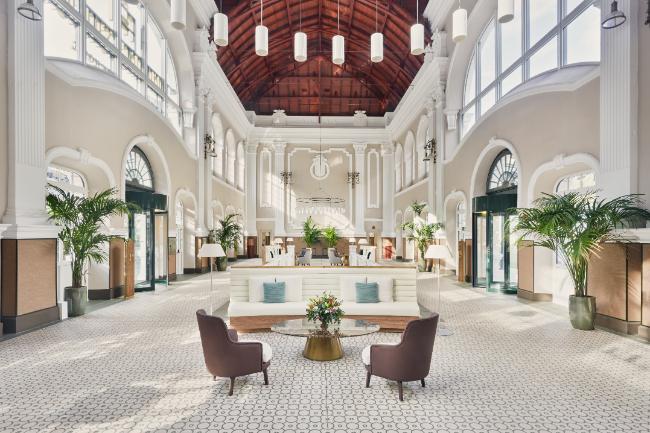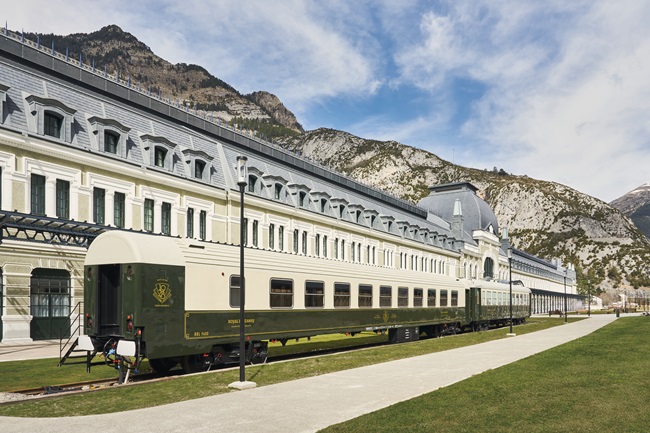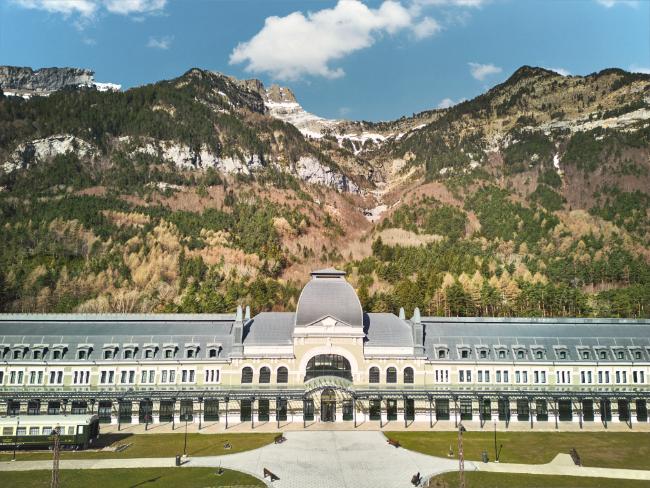Canfranc Estación Hotel Maintains the History of the French/Spanish Railway Station
Just accross the border with Spain, the Canfranc train station has emerged after extensive renovations as a stunning hotel, that showcases the long history and deep connection with France.
If you ever needed to take a nap at a train station, Canfranc Estación, a Royal Hideaway Hotel, is where you can more than comfortably spend the night. Located about 10 kilometers from the French border in the Spanish Pyrenees, the hotel is a restored train station that beautifully reflects its history between France and Spain spanning over 100 years, including a role in World War II. After over 50 years of disuse, the station opened in February, remodeled as a luxury hotel that respects the storied history and grace of the railroad station while providing charming accommodations and an inspiring location for explorers and skiers.
“If there is one thing we can highlight, it is the history of the building,” said David Muñoz, Assistant General Manager of Canfranc Estación. “Inaugurated in 1928, it was one of the most important railway complexes of the 20th century. It has been the protagonist of important historical events and has even survived very conflictive times in our history. Today, walking through the exterior and interior of the building is exciting due to the history that breathes from its walls and can infuse our guests and visitors. The building was declared an Asset of Cultural Interest in 2002.”

The lobby flooded with light © Manolo Yllera
The grand station entrance is now the hotel reception area. According to Muñoz, guests are welcomed from the traditional Spanish side of the station at the walnut check-in desk with a large station clock and Spanish coat of arms hanging above it. The other side of the station has the French coat of arms on the wall which reflects the history of the station as a partnership between France and Spain.
There has long been cross-border traffic between France and Spain but the Pyrenees mountains made railroad service difficult. At the beginning of the 20th century, Spanish officials promoted a grand train station near the Spanish village of Canfranc that both French and Spanish railway operators would share. The vision was that the station would be a prominent hub enabling more international travel and trade. Half of the station would be French territory and the other half Spanish. That concept inspired the size and style of the station resulting in an iron and glass Beaux-Arts building that was 790 feet long with 365 windows and 156 doors that opened to platforms more that 220 yards long that met the French and Spanish train tracks. It would be the second largest train station in Europe.

© Martha Sessums
But to get to the station from France, a tunnel needed to be built. Started in 1912, the Somport railway tunnel was completed in 1915 after a delay with the outbreak of World War I when French construction workers called into the military were replaced by Spanish workers. There were also dozens of bridges that needed to be built to bring the train lines to Canfranc. Another issue – the width of each countries’ train tracks was different. The French track gauge was 4 feet 81/2 inches wide while the Spanish gauge was 5 feet 51/2 inches. Goods and travelers would change from French trains to Spanish trains and continue their journeys.
Construction of the station started in 1923 and was completed in 1928. Situated with a wide view of the surrounding mountains, it had a hospital, restaurant and living quarters for both customs and police officers from France and Spain. The grand opening in 1928 included the president of the French Republic, Gaston Doumergue, and King Alfonso XIII of Spain.

© Manolo Yllera
But for all the big plans, the Canfranc train station had a series of misfortunes. Changing goods from French trains to Spanish trains was slow and never met expectations. The 1929 Wall Street crash didn’t help. In 1931, a fire broke out in the lobby causing much damage. By the early 1930s, passenger traffic averaged only 50 passengers a day. During the Spanish Civil War of 1936 –1939, Franco ordered the tunnels on the Spanish side closed to prevent weapons smuggling to France, although the station remained open serving Spanish needs.
In World War II, the station became known as the “Casablanca of the Pyrenees.” Not only was it a key crossing for goods during the war but became an important route for both Jews and Allied soldiers who escaped into Spain. According to Ramón Javier Campo Fraile, a Canfranc station historian, “In the first years of the war, from 1940 to 1942, thousands of Jews (and non-Jews) fled by train through Canfranc to Lisbon and the United States.” Among those were painters Marc Chagall and Max Ernst. American entertainer Josephine Baker exited France through the Canfranc train station. Traveling the other way were spies that used the station to join the French resistance or pass messages to Allied contacts. But in November 1942, the Nazis took control of the area and escape through Canfranc became difficult. The station was the site of many arrests.

© Martha Sessums
In addition, Spain developed an operational agreement with the Wehrmacht and the station became the transport area of mined tungsten metal heading north while French grain and stolen Swiss gold moved south into Nazi hands. The Germans built several bunkers in the mountainous area around the train station for protection.
Following the end of the war, Canfranc station returned to moving trade and passenger traffic and the following decades brought prosperity. However, that lessened as the ease and types of travel choices changed. On March 20, 1970 a train derailed and demolished a bridge on the French side of the Pyrenees mountains. The French government decided not to rebuild the bridge which forced the closure of the cross-border line.
The result was the grand Canfranc station fell into disuse and disrepair. It was fenced off and closed to the public except for guided tours. Spanish train traffic continued but used a smaller, more modest facility as the station.
In 2013, the government of Aragon became the owner of the station and developed plans to renovate the original Canfranc train station into the current luxury hotel. They worked with the Bardeló Hotel Group to rework the train station being sure to retain the original features and character. Using local designers and architects, the exterior retained its style. The 365 windows were restored to offer views of the mountains and the interior was inspired by the esthetics of the old train station. The 104 rooms use the windows as a key feature to overlook the old train tracks and the surrounding mountains. There are also three restaurants, a wellness centre and plenty to explore on hikes around the hotel.

© Martha Sessums
The hiking trails in the area pass majestic trees and waterways, including a waterfall pounding down multilayered steps with the changing waves of water fascinating to watch. The mountains around the station still have WWII bunkers which are open to explore. They are full of big spiders so be careful.
Winter is here and the Canfranc Estación location is great for skiers. It is close to the resorts of Astún and Candanchú popular not only for skiing but also for music festivals.
After hiking, skiing or other sport, the hotel offers a wellness centre that includes a heated pool area, gym and cabins for treatments and massages. “It is an area designed for the relaxation and enjoyment of our guests, where the main objective is to repair body, soul, and mind,” Muñoz maintains.
Canfranc Estación blends the French and Spanish train station with world events it experienced. It’s a welcoming place to explore the surroundings, appreciate the past and how the present hotel pays homage to history.
“I still remember when we first opened the doors and seeing the excited faces of all those who entered the hotel lobby, and how many of them were thrilled,” said Muñoz. “Even today, 10 months later, it is still happening. This is the best reward for our work and what makes me most proud to be here.”
Plus, the luxury hotel raises the level and quality of any train station nap.

© Martha Sessums
Lead photo credit : The luxury hotel that was once a major train station © Manolo Yllera
Share to: Facebook Twitter LinkedIn Email
More in French history, Pyrenees, train stations, train travel
Leave a reply
Your email address will not be published. Required fields are marked *






REPLY